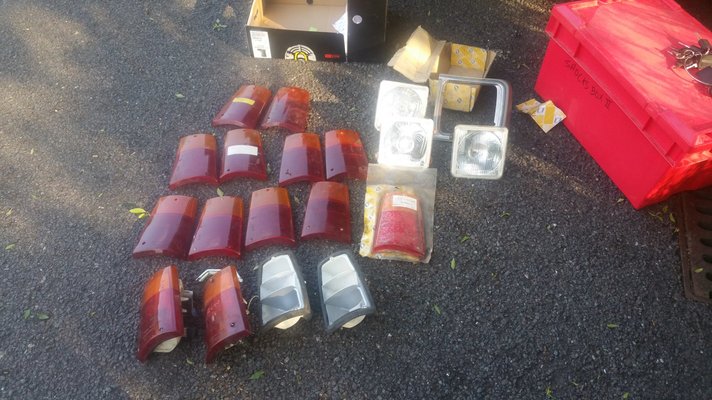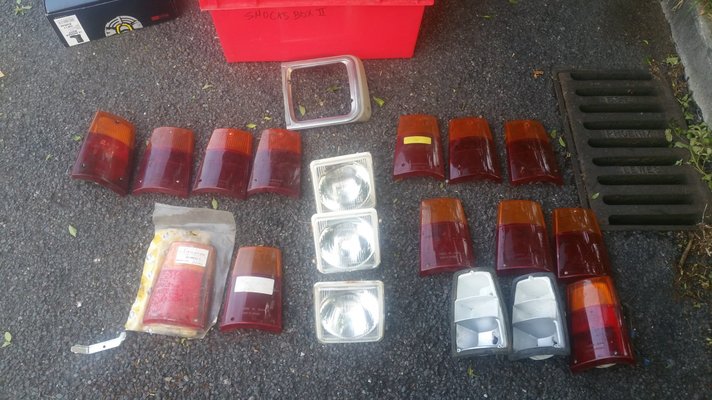I know, and I'm a terrible person for not being in a position to take advantage of that situation. I'm also useless with the telephone and keeping up with things, much more than ever I used to be. Money is unpredictable most of the time, the peril of being self-employed, and all too often the useful job lot turns up when I can't afford it and then, as Sod's Law dictates, it's all gone when I do have the cash. Frustrating for all concerned. So it's been a case of picking things up as and when finances, motivation and time allow. Anyway, we don't want my life story do we? That's rather dull. Let's have another progress update...
Crumbs, another busy day on Crapaud. I bought some new spring clips for the sill trims so I could get those back on. The old clips had rusted out for the most part and were a nuisance to remove. The new clips were even more of a nuisance to fit but I persisted and got there. Cleaned off the rust and flakey paint on the sills and then popped one trim on which fitted well enough, pushed the end caps home which have seen better days and this side was done.
The other side it turns out the trim strip is considerably shorter than it should be. I only found this out after fighting with all the trim clips because I'd foolishly assumed it would be the correct length. Never mind, it doesn't bother me, just part of what this car is all about.
Windscreen was popped out. This has to be the easiest windscreen I've ever removed. The seal had some sort of sealant gunge which meant the top wasn't sitting flush with the frame and allowing water to get trapped. The driver's side had loads of sealant for no real reason and the passenger side practically none. The windscreen has been out before as the green repaint was underneath everything. The whole surround and the seal - which is in surprisingly good shape - were cleaned to get rid of the sealant and rust and so we could make a start on the next job...
Fitting the headlining. After popping all the rods into the relevant holes, the rear tension was set by putting the special plastic piece into the grip rod and then pressing the grip rod down where it was lifted from the previous headlining removal. At the front, a little bit of good strong adhesive was applied before putting the tension on and holding it all down with pegs. It works exceptionally well.
Once it's all dried, the excess fabric and pegs are removed and then the side tension can be set.
There was a couple of inches of excess fabric to remove before I could tuck it away into the grip rods and to prevent puckering on the seams, the roof bow pleats were split (on the fabric, not the stitches) to allow the new headlining to fit smoothly. Here it is before trimming and after front-to-rear tension has been set.

I had thought some of the fabric needed to go in the rear side window holes as when I removed the old headlining that's where it was. However, the grip rod runs all the way to the back so I put it back in there which is much neater. It also reveals where the respray was done by masking off the old headlining but removing the rear side windows. To fit the fabric for side tension you get a large, blunt screwdriver and, working from the seams, push the fabric into the grip rods. If any of the grip rods (I've typed grip rods too many times, it's lost all meaning now) need it, gently tap them down to hold the fabric. It's a really, really fast way of doing a headlining, I like it.
Repeat on the other side until complete. The finished article is really satisfying and it's made the interior a nicer place to be.
With that done, attention could turn to refitting the side windows. I managed to fit this one back-to-front on the first attempt so it had to come out to be refitted, but it was done with a little grunt by my brother and I.
The other side got the same treatment. This went much easier when we found a length of suitable cord but it was still a difficult window to put in due to the shape of it.
Finally, the windscreen went in. It sits in the frame much better than it did before it was removed. I didn't have the special tool for fitting the chrome trim but I do have a tried and tested technique using fingers and a screwdriver carefully. I also found climbing onto the bonnet of Renault 6 from the side is very difficult because it tips much more than you expect.
With all the glass in and the headlining fitted I faffed about refitting the dashboard and then the mirror - which I cleaned the stem on since it had too much green paint on one side - and the visors.
Another shot with flash, so you can see the rabbits.
Mike was in briefly and ran the wiring for the reversing lights, we just need to wire up a switch to operate the existing ones or find some that work from the non-powered switch in the Renault's gearbox. The wiring is at least in for the reversing lights now which makes them easier to sort in the future. Happily running out of jobs to do now.



















































































